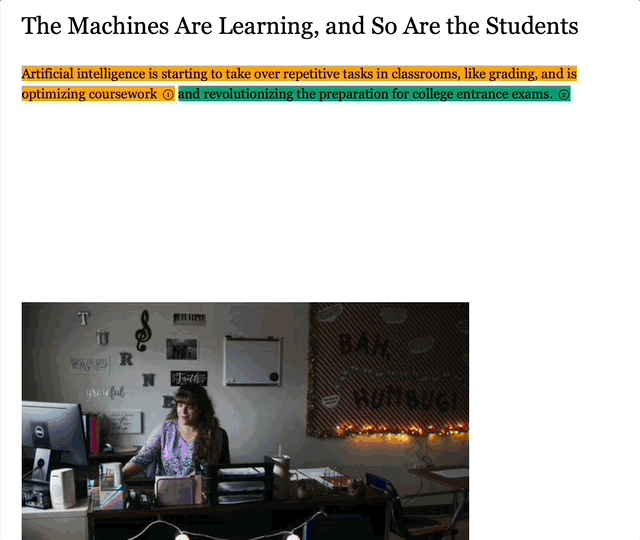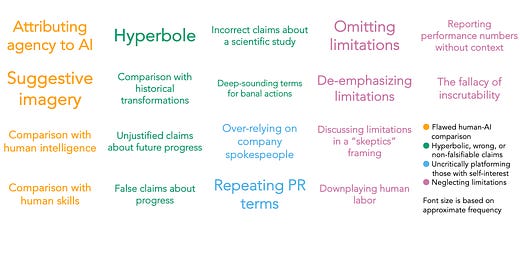Reporting about AI is hard. Companies hype their products and most journalists aren’t sufficiently familiar with the technology. When news articles uncritically repeat PR statements, overuse images of robots, attribute agency to AI tools, or downplay their limitations, they mislead and misinform readers about the potential and limitations of AI.
We noticed that many articles tend to mislead in similar ways, so we analyzed over 50 articles about AI from major publications, from which we compiled 18 recurring pitfalls. We hope that being familiar with these will help you detect hype whenever you see it. We also hope this compilation of pitfalls will help journalists avoid them.
We were inspired by many previous efforts at dismantling hype in news reporting on AI by Prof. Emily Bender, Prof. Ben Shneiderman, Lakshmi Sivadas and Sabrina Argoub, Prof. Emily Tucker, and Dr. Daniel Leufer et al.
You can download a PDF checklist of the 18 pitfalls with examples here.
Example 1: “The Machine Are Learning, and so are the students” (NYT)
We identified 19 issues in this article, which you can read here.
In December 2019, NYT published a piece about educational technology (EdTech) product called Bakpax. It is a 1,500-word, feature-length article that provides neither accuracy, balance, nor context.
It is sourced almost entirely from company spokespeople, and the author borrows liberally from Bakpax's PR materials to exaggerate the role of AI. To keep the spotlight on AI, the article downplays the human labor from teachers that keeps the system running—such as developing and digitizing assignments.
Bakpax shut down in May 2022.
This is hardly a surprise: EdTech is an overhyped space. In the last decade, there have been hundreds of EdTech products that claim to "revolutionize" education. Despite billions of dollars in funding, many of them fail. Unfortunately, the article does not provide any context about this history.

Example 2: “AI may be as effective as medical specialists at diagnosing disease” (CNN)
We identified 9 issues in this article, which you can read here.
In September 2019, CNN published this article about an AI research study. It buries the lede, seemingly intentionally: the spotlight is on the success of AI tools in diagnosis, whereas the study finds that fewer than 1% of papers on AI tools follow robust reporting practices. In fact, an expert quoted at the end of the article stresses that this is the real message of the study.
Besides, the cover image of the article is a robot arm shaking hands with a human, even though the study is about finding patterns in medical images. These humanoid images give a misleading view of AI, as we’ve described here.
Example 3: “AI tested as university exams undergo digital shift” (FT)
You can read the annotated article here.
Many schools and universities have adopted remote proctoring software during the COVID-19 pandemic. These tools suffer from bias and lack of validity, enable surveillance, and raise other concerns. There has been an uproar against remote proctoring from students, non-profits, and even senators.
In November 2021, the Financial Times published an article on a product called Sciolink that presents an entirely one-sided view of remote proctoring. It almost exclusively quotes the creators of Sciolink and provides no context about the limitations and risks of remote proctoring tools.
Eighteen pitfalls in AI journalism
We analyzed over 50 news stories on AI from 5 prominent publications: The New York Times, CNN, Financial Times, TechCrunch, and VentureBeat.
We briefly discuss the 18 pitfalls below; see our checklist for more details and examples.
Flawed human-AI comparison
What? A false comparison between AI tools and humans that implies AI tools and humans are similar in how they learn and perform.
Why is this an issue? Rather than describing AI as a broad set of tools, such comparisons anthropomorphize AI tools and imply that they have the potential to act as agents in the real world.
Pitfall 1. Attributing agency to AI: Describing AI systems as taking actions independent of human supervision or implying that they may soon be able to do so.
Pitfall 2. Suggestive imagery: Images of humanoid robots are often used to illustrate articles about AI, even if the article has nothing to do with robots. This gives readers a false impression that AI tools are embodied, even when it is just software that learns patterns from data.
Pitfall 3. Comparison with human intelligence: In some cases, articles on AI imply that AI algorithms learn in the same way as humans do. For example, comparisons of deep learning algorithms with the way the human brain functions are common. Such comparisons can lend credence to claims that AI is “sentient”, as Dr. Timnit Gebru and Dr. Margaret Mitchell note in their recent op-ed.
Pitfall 4. Comparison with human skills: Similarly, articles often compare how well AI tools perform with human skills on a given task. This falsely implies that AI tools and humans compete on an equal footing—hiding the fact that AI tools only work in a narrow range of settings.
Hyperbolic, incorrect, or non-falsifiable claims about AI
What? Claims about AI tools that are speculative, sensational, or incorrect can spread hype about AI.
Why is this an issue? Such claims give a false sense of progress in AI and make it difficult to identify where true advances are being made.
Pitfall 5. Hyperbole: Describing AI systems as revolutionary or groundbreaking without concrete evidence of their performance gives a false impression of how useful they will be in a given setting. This issue is amplified when AI tools are deployed in a setting where they are known to have past failures—we should be skeptical about the effectiveness of AI tools in these settings.
Pitfall 6. Uncritical comparison with historical transformations: Comparing AI tools with major historical transformations like the invention of electricity or the industrial revolution is a great marketing tactic. However, when news articles adopt these terms, they can convey a false sense of potential and progress—especially when these claims are not backed by real-world evidence.
Pitfall 7. Unjustified claims about future progress: Claims about how future developments in AI tools will affect an industry, for instance, by implying that AI tools will inevitably be useful in the industry. When these claims are made without evidence, they are mere speculation.
Pitfall 8. False claims about progress: In some cases, articles include false claims about what an AI tool can do.
Pitfall 9. Incorrect claims about what a study reports: News articles often cite academic studies to substantiate their claims. Unfortunately, there is often a gap between the claims made based on an academic study and what the study reports.
Pitfall 10. Deep-sounding terms for banal actions: As Prof. Emily Bender discusses in her work on dissecting AI hype, using phrases like “the elemental act of next-word prediction” or “the magic of AI” implies that an AI tool is doing something remarkable. It hides how mundane the tasks are.
Uncritically platforming those with self-interest
What? News articles often use PR statements and quotes from company spokespeople to substantiate their claims without providing adequate context or balance.
Why is this an issue? Emphasizing the opinions of self-interested parties without providing alternative viewpoints can give an over-optimistic sense of progress.
Pitfall 11. Treating company spokespeople and researchers as neutral parties: When an article only or primarily has quotes from company spokespeople or researchers who built an AI tool, it is likely to be over-optimistic about the potential benefits of the tool.
Pitfall 12. Repeating or re-using PR terms and statements: News articles often re-use terms from companies’ PR statements instead of describing how an AI tool works. This can misrepresent the actual capabilities of a tool.
Limitations not addressed
What? The potential benefits of an AI tool are emphasized, but the potential limitations are not addressed or emphasized.
Why is this an issue? A one-sided analysis of AI tools can hide the potential limitations of these tools.
Pitfall 13. No discussion of potential limitations: Limitations such as inadequate validation, bias, and potential for dual-use plague most AI tools. When these limitations are not discussed, readers can get a skewed view of the risks associated with AI tools.
Pitfall 14. Limitations de-emphasized: Even if an article discusses limitations and quotes experts who can explain them, limitations are often downplayed in the structure of the article, for instance by positioning them at the end of the article or giving them limited space.
Pitfall 15. Limitations addressed in a “skeptics” framing: Limitations of AI tools can be caveated in the framing of the article by positioning experts who explain these limitations as skeptics who don’t see the true potential of AI. Prof. Bender discusses this issue in much more detail in her response to an NYT Mag article.
Pitfall 16. Downplaying human labor: When discussing AI tools, articles often foreground the role of technical advances and downplay all the human labor that is necessary to build the system or keep it running. The book Ghost Work by Dr. Mary L. Gray and Dr. Siddharth Suri reveals how important this invisible labor is. Downplaying human labor misleads readers into thinking that AI tools work autonomously, instead of clarifying that they require significant overhead in terms of human labor, as Prof. Sarah T. Roberts discusses.
Pitfall 17. Performance numbers reported without uncertainty estimation or caveats: There is seldom enough space in a news article to explain how performance numbers like accuracy are calculated for a given application or what they represent. Including numbers like “90% accuracy” in the body of the article without specifying how these numbers are calculated can misinform readers about the efficacy of an AI tool. Moreover, AI tools suffer from performance degradations under even slight changes to the datasets they are evaluated on. Therefore, absolute performance numbers can mislead readers about the efficacy of these tools in the real world.
Pitfall 18. The fallacy of inscrutability: Referring to AI tools as inscrutable black boxes is a category error. Instead of holding the developers of these tools accountable for their design choices, it shifts scrutiny to the technical aspects of the system. Journalists should hold developers accountable for the performance of AI tools rather than referring to these tools as black boxes and allowing developers to evade accountability.
While these 18 pitfalls appear in the articles we analyzed, there are other issues that go beyond individual articles. For instance, when narratives of AI wiping out humanity are widely discussed, they overshadow current real-world problems such as bias and the lack of validity in AI tools. This underscores that news media must play its agenda-setting role responsibly.
We thank Klaudia Jaźwińska, Michael Lemonick, and Karen Rouse for their feedback on a draft of this article. We re-used the code from Molly White et al.’s The Edited Latecomers’ Guide to Crypto to generate our annotated articles.






Excellent and useful piece. The very last link for the “agenda setting quality” of media is broken. Were there other citations to replace it?
I can see the “black box” nature of AI being a cop out for applications like those in EdTech but would “black box” discussion be useful in some limited circumstances like general purpose LLMs?
Flawed human-AI comparisons always get me, they are modes of intelligence so fundamentally different, that making comparisons is fishy from the get go. How many matches does it take muzero to get to the level of basic competency a human can get in just a couple of games? It's orders of magnitude different. What's the difference in rate of energy consumption per "learning unit"? Again, radically different. These differences are understandable once you consider how disparate their methods and material substrates are, but this always gets lost in the hype. I understand non-technical people making such oversights, but you often see even technical people making comparisons willy-nilly.